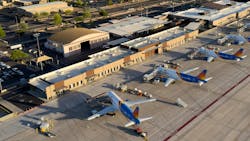Mesa Gateway Airport South Concourse Terminal Expansion Serves as A Model for Modernization
The South Concourse Terminal Expansion at Mesa Gateway Airport (AZA) represents a transformative project that enhances the airport’s ability to serve its growing passenger base. The new 30,000-square-foot terminal, which replaced an outdated temporary facility, adds five new gates and significantly improves passenger flow and operational efficiency. Through strategic planning, innovative construction techniques, and strong collaboration with industry partners, AZA has successfully positioned itself as a leading regional airport.
"We’ve grown this airport piece by piece over the years," said J. Brian O’Neill, Executive Director and CEO of AZA. "As demand continued to increase, we needed to replace our outdated infrastructure to better serve our passengers and airline partners. This project was a long time coming, and we knew it was essential to our future."
The Need and Scope for the Project
AZA has long operated with limited infrastructure, particularly when it came to terminal capacity. Prior to the expansion, the airport relied on a four-gate, 10,000-square-foot temporary facility that was initially meant to be a short-term solution. However, the airport’s steady growth, combined with Allegiant Air’s increasing presence, stretched the facility beyond its limits. When the COVID-19 pandemic hit, the lack of space became an even greater issue.
"The old terminal wasn’t just outdated—it was a real challenge to operate during peak periods," said Ryan Smith, Director of Communications and Government Relations at AZA. "We could only use one gate at a time in that facility during the pandemic. It became clear that we needed a more permanent solution."
Recognizing the urgency, airport officials identified opportunities for funding through federal, state, and local channels. With $14.4 million secured through the Bipartisan Infrastructure Law (BIL) Terminal Modernization Program, $7 million from the State of Arizona, and additional discretionary funds from the Federal Aviation Administration (FAA), the airport was able to fully fund the $28 million project.
"We were fortunate to have strong support from our congressional delegation, the FAA, and the state," said O’Neill. "This project truly came together through a collective effort, and it’s a great example of how regional airports can successfully secure the resources they need."
Design, Construction, and Execution
With funding secured, the project moved quickly into the design and construction phase. DWL Architects + Planners led the architectural vision, focusing on a balance between modernization and maintaining the airport’s unique character. A key aspect of the design was the integration of Arizona’s natural landscape, featuring an open-air courtyard and an intuitive passenger flow that improves the travel experience.
"The design reflects the identity of this region while also meeting modern aviation standards," said Sandra Kukla, President of DWL Architects. "One of the signature elements is what we call the ‘walk through the desert’—a courtyard that brings passengers closer to the landscape and climate that make Arizona unique."
McCarthy Building Companies, serving as the Construction Manager at Risk (CMAR), played a pivotal role in ensuring the project was delivered on time and within budget. To prevent disruptions to airport operations, the team first constructed a temporary 6,300-square-foot tension fabric terminal. This allowed AZA to maintain its flight schedule and even increase capacity during construction.
"Building the temporary terminal in just 12 weeks was a major challenge, but it was essential," said Thomas Assante, Senior Project Director with McCarthy. "It gave us the flexibility we needed to move forward without shutting down operations. At the same time, we incorporated prefabrication, modular construction, and Building Information Modeling (BIM) to keep the timeline on track."
The execution of the permanent terminal was completed in under 12 months—an impressive feat given the complexity of building in an active airfield environment. McCarthy implemented rigorous FAA compliance measures and phased construction strategies to minimize impact on airport operations.
"Safety was a top priority," said Assante. "We conducted weekly audits, ensured strict adherence to FAA regulations, and worked closely with airport leadership to coordinate every step. The result was zero lost-time incidents over 111,000 labor hours."
The new terminal also includes several passenger-centric improvements. Enhanced accessibility features, such as a hearing loop system embedded in the flooring, provide greater support for travelers with hearing impairments. Energy-efficient lighting and HVAC systems further improve sustainability, while the layout was optimized to reduce walking distances and improve passenger comfort.
One of the biggest takeaways from this project was the importance of early stakeholder engagement and flexible construction planning. AZA’s leadership worked closely with airlines, local and state governments, and industry partners to ensure the project met the airport’s long-term goals while staying within budget.
"Communication was key," said Smith. "We worked extensively with Allegiant and other stakeholders to make sure their needs were incorporated. The ability to maintain capacity throughout the construction process was a major win."
Funding for the project was a collaborative effort that showcased the power of federal, state, and local investment in regional aviation infrastructure. The $14.4 million BIL grant was critical in getting the project off the ground, while the $7 million from the State of Arizona helped bridge the remaining gap. Additional FAA discretionary funding provided the final piece of the puzzle.
"This project is proof that if you have a clear vision and strong partnerships, you can secure the funding needed to bring it to life," said O’Neill. "It’s a great model for other regional airports looking to modernize."
The Future of Mesa Gateway Airport
With the South Concourse Terminal Expansion complete, AZA is now well-positioned for future growth. The additional gates not only allow for increased flight capacity but also open the door for new airline partners and routes.
"This project has completely transformed how we operate," said O’Neill. "We now have an 11-gate facility where we can run simultaneous flights without constraints. That’s a game-changer for our long-term growth."
The expansion also enhances AZA’s appeal to leisure travelers, particularly with its signature outdoor post-security waiting areas. The combination of modern design, improved amenities, and a streamlined passenger experience gives the airport a competitive edge in attracting new business.
"For years, our goal has been to evolve while maintaining what makes this airport special," said Kukla. "With this expansion, we’ve done exactly that. It’s a model for other regional airports looking to grow efficiently and cost-effectively."







